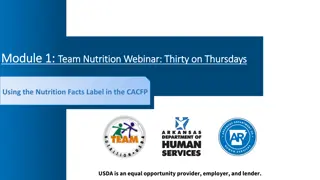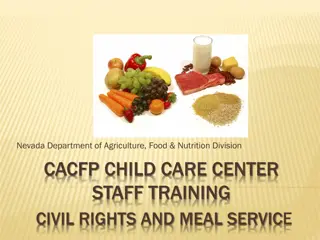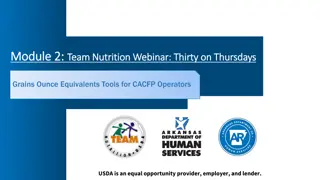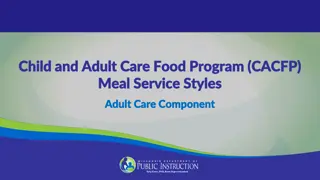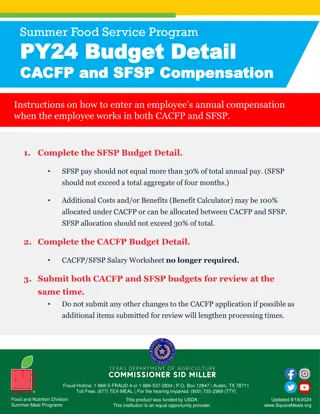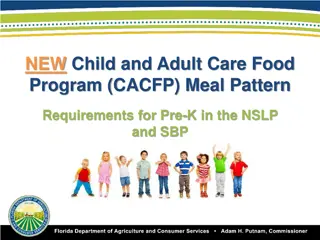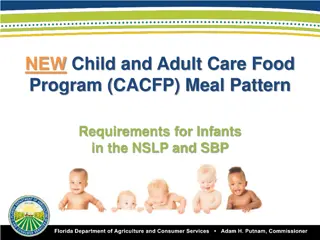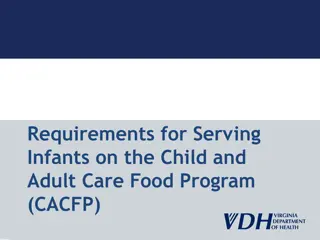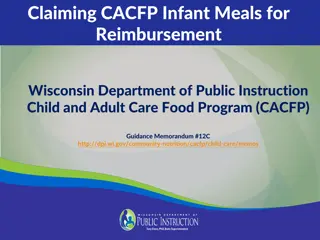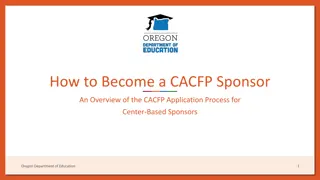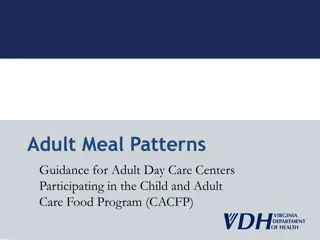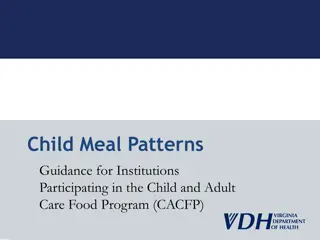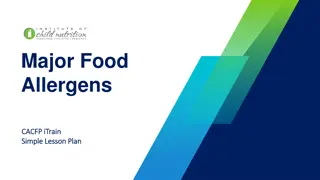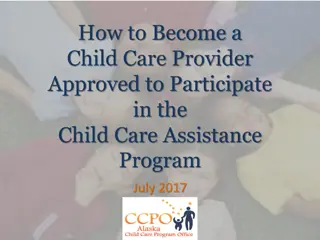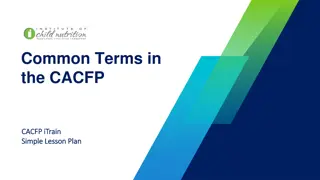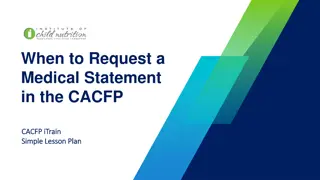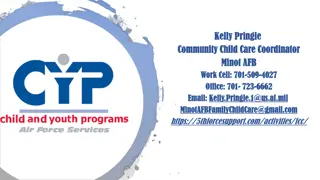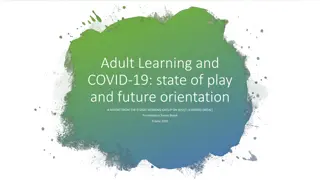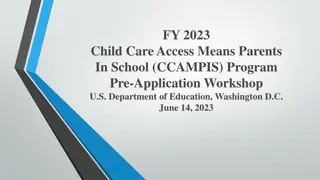Overview of Child and Adult Care Food Program (CACFP)
The Child and Adult Care Food Program (CACFP) is a federally funded program aimed at subsidizing eligible institutions to provide nutritious meals to children and adults, promoting lifelong healthy eating and physical activity habits. Administered by the USDA and implemented by various programs, CACFP aims to support afterschool care, adult day care centers, and family day care homes among others. USDA handbooks provide guidance, and additional resources can be found online. Training objectives include reasons for disallowing meals for reimbursement, VDH actions for deficiencies, changes to USDA guidelines on milk, and requirements for creditable smoothie items.
Download Presentation

Please find below an Image/Link to download the presentation.
The content on the website is provided AS IS for your information and personal use only. It may not be sold, licensed, or shared on other websites without obtaining consent from the author. Download presentation by click this link. If you encounter any issues during the download, it is possible that the publisher has removed the file from their server.
E N D
Presentation Transcript
The Child and Adult Care Food Program (CACFP)
Goal of the CACFP Subsidize eligible institutions for serving nutritious meals to children and eligible adults Foster lifelong healthy eating and physical activity habits
Background of the CACFP The CACFP is a Federally funded Child Nutrition Program. Authorized by the United States Congress Federally administered by the United States Department of Agriculture (USDA) Administered in Virginia by the Department of Health
Who is Implementing the Program? Afterschool Care Programs At-Risk Afterschool Outside School Hours Care Adult Day Care Centers Emergency Shelters Family Day Care Homes Child Care Centers
USDA Handbooks Serious Deficiency, Suspension, & Appeals for State Agencies and Sponsoring Organizations Released: December 2013 Users: State Agencies and Sponsors At-risk Afterschool Care Handbook Released: July 2013(revised) Users: State Agencies and Sponsors Guidance for Management Plans and Budgets Released: December 2013 Users: State Agencies and Sponsors
USDA Handbooks Adult Day Care Handbook Released: January 2014 Users: State Agencies and Sponsors Independent Child Care Centers Handbook Released: May 2014 Users: State Agencies and Sponsors
CACFP Resources on the Web http://www.fns.usda.gov/cacfp/child-and- adult-care-food-program http://www.vahealth.org/DCN/cacfp/index.h tm
Updates on the Child and Adult Food Care Program (CACFP) from VDH and the USDA
Training Objectives List the reasons that VDH might disallow meals and/or snacks for reimbursement. Describe which deficiencies require VDH action. Discuss changes to the USDA s guidelines for CACFP programs related to milk Explain what is required for smoothies to be deemed creditable items
Reasons for Disallowing Meals/Snacks Claiming meals for participant not on roster No written menu for claimed meals or snacks Required food component(s) missing Non-creditable items being counted as a component Less than 2 servings of fruit and/or vegetable component being served for lunch or supper Planned portion sizes not age appropriate
Reasons for Disallowing Meals/Snacks Serving meals/snacks outside of approved hours Meal counts exceed # of children in attendance Inadequate quantity of milk/food provided for # of meals served Meals served with substitute of component for medical reasons without a proper medical note on file
Reasons for Disallowing Meals/Snacks Insufficient quantity of milk/food purchased to meet amount required for the claimed meal service Meals claimed on a day center is not in operation Absence of roster, daily attendance records or daily meal counts to substantiate # of meals claimed
Deficiencies Requiring Fiscal Action Expenditures not identified in approved budget Expenditures for which there are no receipts available or for which receipts do not support the meals served; Audit report findings of questioned costs
Milk in the CACFP Milk is a required component of all meals except for snack in the CACFP With snacks, milk may be served as a component when the other component is not juice When used as an ingredient in cooked meals, the milk serving requirement has not been met.
Milk in the CACFP Allowable types for participants > 2 Low fat (1% or fat free) Lactose-reduced or lactose free, buttermilk or acidified milk Unflavored or flavored, including chocolate or strawberry Goat s milk (only if pasteurized) USDA-approved non-dairy milk substitutes products (e.g. some brands of soy milk) at the parent/guardian s request as long as it is nutritionally equivalent to cow s milk.
Milk in the CACFP: Exceptions Medical or Other Special Dietary Need If a participant cannot consume fluid milk due to medical or other special dietary needs (e.g. vegetarian), non-dairy beverages may be served in lieu of milk If the substitute is not nutritionally equivalent to milk (e.g. juice, water), a signed medical statement is required for the meal to be claimed.
Milk Served in the CACFP: Exceptions Disability If a disability directly affects a child s ability to consume milk and a signed medical statement is on file, the facility must purchase and can claim alternatives that do not conform to the meal pattern. Statement must include: Child s disability and why it restricts child s diet Major life activity affected by the disability Food(s) to be omitted from the child s diet; and Appropriate substitutions
Creditable Smoothies Milk and fruit Milk and pureed fruit **Milk used must be 1% or fat free for children > 2 years old and whole for children 12-24 months
Non-Creditable Smoothies Vegetable Commercially prepared Served as a snack without a second component Added nutritional supplement Yogurt except when used to credit as a meat/meat alternate for the breakfast meal pattern
Smoothies and Meal Components May be credited toward the fluid milk requirements for lunch and breakfast. **Fluid milk must also be offered in the required quantity to meet the meal requirements. Juice and pureed fruit may be credited as fruit juice **Program operators are strongly encouraged to offer additional fruit options.


